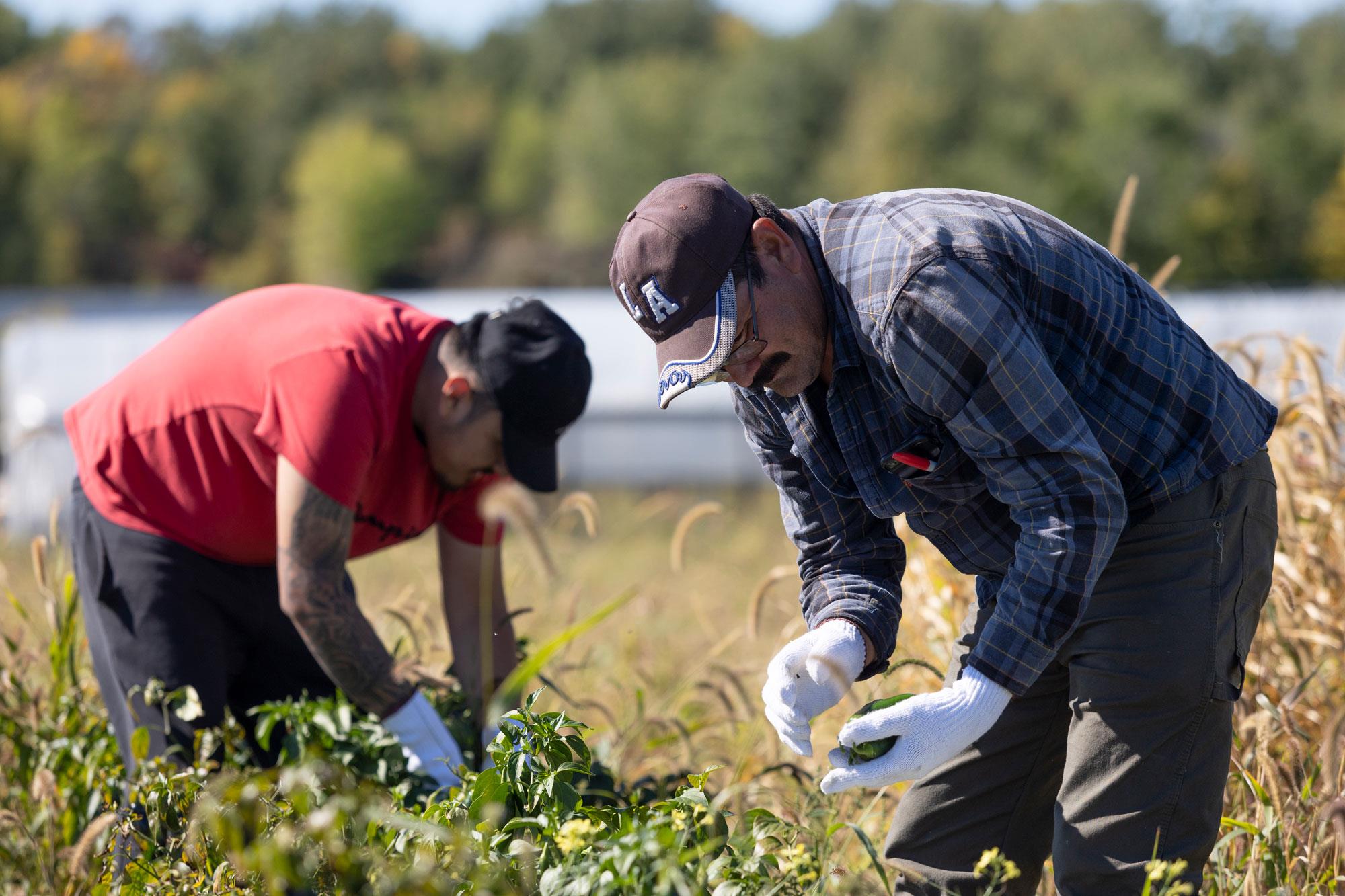Home>Gardening Techniques>Plant Care>What Is Succession Planting


Plant Care
What Is Succession Planting
Modified: January 22, 2024
Learn about the importance of succession planting in plant care, and how it ensures a continuous harvest throughout the growing season.
(Many of the links in this article redirect to a specific reviewed product. Your purchase of these products through affiliate links helps to generate commission for Chicagolandgardening.com, at no extra cost. Learn more)
Table of Contents
- Introduction
- Definition of Succession Planting
- Benefits of Succession Planting
- Strategies for Succession Planting
- Choosing the Right Crops for Succession Planting
- Planning Your Succession Planting Schedule
- Implementing Succession Planting in Your Garden
- Tips for Successful Succession Planting
- Potential Challenges and How to Overcome Them
- Conclusion
Introduction
Welcome to the world of successful gardening! Whether you”re an experienced gardener or just starting out, one concept that can significantly enhance your plant care efforts is succession planting. This technique not only maximizes the productivity of your garden but also ensures a continuous harvest throughout the growing season.
Succession planting, also known as staggered planting or sequential planting, involves sowing or transplanting crops at different intervals. Instead of planting all your seeds or seedlings at once, you strategically plan and implement multiple plantings throughout the season. This method allows you to utilize your garden space efficiently and extend the production of fresh vegetables, herbs, and flowers all year round.
One of the key benefits of succession planting is that it helps avoid the common problem of a glut of vegetables maturing all at once, followed by a scarcity for the rest of the season. By staggering plantings, you can ensure a steady supply of produce, preventing waste and ensuring a bountiful harvest over an extended period of time.
Another advantage of succession planting is the ability to optimize the use of resources such as soil nutrients and water. As plants reach the end of their life cycle, you can quickly replace them with new seedlings, ensuring that the garden beds remain productive and vibrant throughout the season. This technique also helps to reduce the risk of disease and pest infestations since you regularly refresh the growing areas.
Whether you have a small backyard garden or a larger plot, succession planting can be easily adapted to suit your space and needs. By carefully selecting crops with different maturity rates and understanding their specific requirements, you can create a carefully orchestrated planting schedule that maximizes your garden”s potential.
Throughout this article, we will explore the various strategies for implementing succession planting, the crops that are best suited for this technique, and how to overcome potential challenges. By the end, you”ll be equipped with the knowledge and skills to make your garden thrive with a constant rotation of delicious and beautiful plants.
Definition of Succession Planting
Succession planting is a gardening technique that involves sequentially planting crops at different intervals to extend the growing season and ensure a continuous harvest. Instead of planting all the seeds or seedlings at once, gardeners strategically space out their plantings to maximize productivity and optimize resource utilization.
The goal of succession planting is to avoid the feast-or-famine cycle that often occurs in traditional gardening methods. By staggering plantings, gardeners can ensure a steady supply of fresh produce throughout the growing season, preventing a sudden abundance or scarcity of crops.
This technique is particularly useful for annual crops, which have a defined lifespan from seed to harvest. By planning and scheduling successive plantings, gardeners can ensure a constant rotation of crops, resulting in a continuous supply of vegetables, herbs, or flowers throughout the season.
In succession planting, the timing of each planting is crucial. Gardeners must consider the plant”s growth rate, maturity period, and preferred growing conditions. By understanding these factors, they can determine the appropriate intervals between plantings, ensuring that new crops are ready for harvest as older ones reach the end of their life cycle.
Succession planting can be implemented in various ways, depending on the type of plants and the available garden space. Gardeners can use techniques such as intercropping, where fast-growing crops are planted alongside slow-growing ones, or by rotating crops in different sections of the garden. By utilizing these strategies, gardeners can make the most efficient use of their garden beds and increase overall productivity.
Overall, succession planting is a dynamic approach to gardening that allows for continuous production, improved resource management, and a more balanced harvest. By implementing this technique, gardeners can enjoy a steady supply of fresh, homegrown produce throughout the growing season.
Benefits of Succession Planting
Succession planting offers a multitude of benefits that can greatly enhance your gardening experience. By implementing this technique, you can maximize the productivity of your garden and enjoy a range of advantages:
- Continuous Harvest: One of the primary benefits of succession planting is the ability to enjoy a continuous harvest throughout the growing season. By staggering plantings, you can ensure a steady supply of fresh crops, preventing a sudden abundance followed by a scarcity.
- Reduced Waste: Succession planting helps to prevent waste by avoiding a surplus of produce maturing at once. Instead, you can harvest crops in smaller, more manageable quantities, reducing the chances of excess produce going to waste.
- Optimized Resource Utilization: By planting crops in succession, you can make the most efficient use of your garden space and resources. As plants reach the end of their life cycle, you can quickly replace them with new seedlings, ensuring that the soil nutrients and water are consistently utilized.
- Extended Growing Season: Succession planting allows you to extend the growing season by continuously sowing or transplanting new crops. This is especially useful in areas with shorter growing seasons, enabling you to enjoy fresh produce for a longer period of time.
- Improved Disease and Pest Management: By regularly refreshing garden beds with new plantings, you can reduce the risk of diseases and pests building up over time. Removing old plants and replacing them with younger ones helps to maintain a healthier growing environment.
- Flexibility and Adaptability: Succession planting offers flexibility to adapt to changing weather conditions, disease outbreaks, or other unforeseen challenges. If a crop fails or underperforms, you can quickly replant without having to wait for the next growing season.
These are just a few of the many benefits that succession planting can bring to your garden. By adopting this technique, you can optimize resource utilization, enjoy a continuous supply of fresh produce, and increase overall productivity in your gardening efforts.
Strategies for Succession Planting
To successfully implement succession planting in your garden, it’s essential to employ effective strategies that optimize your space, time, and resources. Here are some key strategies to consider:
- Interplanting: Interplanting involves planting fast-growing crops alongside slow-growing ones. This strategy maximizes the productivity of your garden beds by utilizing the space between larger plants. For example, you can sow quick-growing lettuce or radishes between slower-growing tomatoes or broccoli.
- Successive Rows: Another method is to plant different crops in successive rows, allowing for staggered harvests. For instance, you can sow a row of beans, then a week later, sow another row. This ensures a continuous supply of beans throughout the season.
- Relay Planting: Relay planting involves sowing or transplanting new crops in between existing ones as they near maturity. This strategy maximizes the use of space and extends the harvest window. For example, as you harvest a row of lettuce, you can immediately sow new lettuce seeds in the same space.
- Overlapping Plantings: Overlapping plantings involves starting new seeds or seedlings a few weeks before the previous crop is expected to finish. This strategy ensures a seamless transition between harvests and minimizes any gaps in production.
- Sequential Planting: Sequential planting refers to making multiple plantings of the same crop at regular intervals throughout the growing season. This technique provides a continuous supply of the same crop as each successive planting reaches maturity.
- Crop Rotation: Incorporating crop rotation into your succession planting plan is essential for maintaining soil fertility and preventing disease and pest buildup. Rotate crops in different sections of your garden each year to break the disease cycle and ensure optimal soil health.
When determining your succession planting strategy, consider factors such as the maturity period of the crops, space availability, and your specific gardening goals. Be sure to research the specific requirements of each crop and plan accordingly to avoid overcrowding or nutrient depletion.
By implementing these strategies, you can optimize your garden space, ensure a continuous harvest, and enjoy the benefits of succession planting throughout the growing season.
Choosing the Right Crops for Succession Planting
When practicing succession planting, selecting the right crops is crucial for a successful and productive garden. Here are some factors to consider when choosing crops for succession planting:
- Maturity Rate: Look for crops with varying maturity rates. This will ensure that you have a continuous supply of fresh produce throughout the growing season. Choose a mix of fast-maturing crops, such as lettuce or radishes, and slower-maturing ones like tomatoes or peppers.
- Space Efficiency: Consider the space requirements of each crop. Opt for compact or vertically growing varieties that take up less space, allowing you to maximize your garden’s productivity. Examples include bush beans, climbing peas, or compact varieties of cucumbers.
- Succession Planting Compatibility: Some crops are more suitable for succession planting than others. Choose crops that can tolerate replanting or have a long harvesting period. Leafy greens, such as spinach or kale, are excellent choices as they can be continuously harvested as new leaves grow.
- Succession Planting Combinations: Consider companion planting and crop combinations that work well together. Some crops enhance each other’s growth or deter pests when planted in close proximity. For instance, planting onions with carrots can help repel carrot fly.
- Personal Preferences: Select crops that you and your family enjoy eating. Succession planting allows you to harvest smaller quantities of a variety of crops, so choose plants that will be consumed in a timely manner.
- Crop Diversity: Aim for a diverse selection of crops to maximize the nutritional content and flavor in your harvest. Include a mix of vegetables, herbs, and even flowering plants to support beneficial insects and promote pollination.
By carefully considering these factors, you can create a well-rounded succession planting plan that ensures a continuous harvest of diverse and delicious crops throughout the growing season.
Planning Your Succession Planting Schedule
Creating a well-thought-out succession planting schedule is crucial for maximizing the productivity of your garden and ensuring a continuous harvest. Here are some steps to help you plan your succession planting schedule:
- Know your average frost dates: Understanding your region’s average frost dates is essential for planning your planting schedule. This information will help you determine when to start seeds or transplant seedlings outdoors.
- Research crop maturity periods: Determine the average days to maturity for each crop you intend to grow. This information will guide you in scheduling your successive plantings.
- Calculate the desired harvest dates: Based on your family’s consumption needs, calculate the ideal harvest dates for each crop. Consider factors such as the plant’s growth rate and your desired quantity of produce.
- Create a timeline: Using a calendar or a gardening app, map out the planting dates for each crop. Start with the earliest crop, considering its time to maturity, and work backward to determine the appropriate intervals between successive plantings.
- Consider environmental conditions: Take into account your local climate conditions, such as temperature and rainfall patterns. Some crops thrive in cooler weather, while others prefer warmer conditions. Plan your successions accordingly to ensure optimal growing conditions.
- Factor in crop rotations: If you practice crop rotation, ensure that you rotate crops in different sections of your garden with each successive planting. This helps maintain soil health and prevents the buildup of disease and pests.
- Consider interplanting opportunities: Look for opportunities to interplant fast-maturing crops between the slower-growing ones. For example, you can plant lettuce between rows of tomatoes or radishes between rows of beans.
- Stay flexible: Be prepared to adjust your planting schedule as needed. Factors such as weather fluctuations, pest outbreaks, or personal circumstances may require you to alter your plans. Stay adaptable and make adjustments accordingly.
By meticulously planning your succession planting schedule, you can ensure a continuous harvest and maximize the productivity of your garden throughout the growing season. Regularly review and update your schedule to account for any changes and to fine-tune your planting strategy as you gain more experience.
Implementing Succession Planting in Your Garden
Implementing succession planting in your garden is an exciting and rewarding endeavor. To effectively incorporate this technique into your gardening practices, follow these steps:
- Prepare your garden beds: Ensure that your garden beds are well-prepared and amended with organic matter to provide optimal growing conditions for your plants. Clear away any debris, weeds, or spent plants from previous harvests.
- Plan your garden layout: Consider the space requirements and compatibility of your chosen crops. Design your garden layout to optimize the use of space by interplanting compatible crops or staggering rows for successive plantings.
- Start seeds indoors: For crops that require an early start, such as tomatoes or peppers, start seeds indoors according to your planned succession planting schedule. This gives the young seedlings a head start before transplanting them outdoors.
- Directly sow seeds: For crops that tolerate direct sowing, such as radishes or lettuce, sow seeds directly into the garden bed at the appropriate intervals based on your planned successions. Follow the planting instructions on seed packets for optimal spacing and depth.
- Transplant seedlings: For crops that require transplanting, such as broccoli or cabbage, start seedlings indoors or purchase them from a reputable nursery. Transplant the seedlings into the garden bed according to your planned successions, ensuring proper spacing and care.
- Maintain proper care: Water your plants regularly to ensure optimal moisture levels. Monitor and address any pest or disease issues promptly. Fertilize as needed, following the specific requirements of each crop, and provide support structures for taller plants if necessary.
- Harvest and replant: As crops reach maturity, harvest them regularly, ensuring you leave space for the next succession planting. Remove any spent plants, add compost or organic matter to replenish the soil, and replant with new seedlings or seeds according to your schedule.
- Monitor and adjust: Continuously assess the progress of your succession plantings. Monitor the growth rate and health of each crop and make any necessary adjustments to your planting schedule, spacing, or care regimen based on your observations and experience.
Implementing succession planting in your garden requires careful planning, regular maintenance, and ongoing observation. With practice, you’ll find the rhythm that works best for your specific garden and growing conditions, leading to a successful and abundant harvest throughout the growing season.
Tips for Successful Succession Planting
To ensure successful succession planting in your garden, consider the following tips and tricks:
- Plan and organize: Create a detailed planting schedule and keep a garden journal to track your progress and make adjustments as needed.
- Choose the right varieties: Select crop varieties that are well-suited for your growing conditions, including temperature, sunlight, and soil type.
- Provide adequate spacing: Pay attention to recommended spacing guidelines for each crop to promote healthy growth and avoid overcrowding.
- Practice proper soil nutrition: Prioritize soil health by regularly incorporating organic matter, such as compost or well-aged manure, to replenish nutrients and enhance soil structure.
- Implement companion planting: Companion planting techniques can help to deter pests, attract beneficial insects, and maximize productivity in your garden. Research plant compatibility for successful pairings.
- Protect your plants: Use physical barriers, such as row covers or netting, to protect young plants from pests, harsh weather conditions, or excessive heat.
- Water consistently: Adequate and consistent watering is crucial for plant health. Monitor soil moisture levels and adjust your watering schedule as needed, taking into account weather conditions and the specific requirements of each crop.
- Harvest promptly: Regularly harvest mature crops to encourage continuous production and help prevent overcrowding in the garden beds.
- Rotate crops: Practice crop rotation to prevent disease buildup and manage nutrient depletion in the soil. Avoid planting the same crop in the same location year after year.
- Stay vigilant: Regularly inspect your plants for signs of pests or diseases. Early detection will allow you to take appropriate action before it spreads to other plants.
- Learn from experience: Succession planting is a learning process. Take note of what works and what doesn’t in your garden and adjust your approach for future seasons based on your observations.
By following these tips, you can increase your chances of having a successful succession planting season and enjoy a continuous supply of fresh produce from your garden.
Potential Challenges and How to Overcome Them
While succession planting offers many benefits, there are some potential challenges that you may encounter. Here are a few common challenges and strategies to overcome them:
- Timing and Synchronization: Ensuring that each planting is timed correctly and synchronized with the right intervals can be challenging. To overcome this, use a gardening app or calendar, and set reminders for each planting date. Keeping a detailed schedule will help you stay organized and on track.
- Overcrowding: It’s important to avoid overcrowding your plants, as this can lead to competition for resources and decrease productivity. Properly space your crops according to the specific requirements of each plant and thin out any seedlings as they grow to maintain optimal spacing.
- Pests and Diseases: Succession planting may increase the risk of pests and diseases affecting your crops. To mitigate this, implement regular monitoring, practice good garden hygiene, and use companion planting techniques to attract beneficial insects that can help control pests.
- Resource Management: Succession planting requires effective management of resources such as water and nutrients. Be mindful of the specific needs of each crop and provide appropriate irrigation and fertilization. Additionally, regularly replenish the soil with organic matter to maintain its fertility.
- Weather Variability: Unpredictable weather patterns can pose challenges for succession planting. Use row covers or tunnels to protect young plants from extreme temperatures or unexpected frosts. Consider using portable containers or raised beds that can be moved indoors during inclement weather.
- Failure to Germinate or Grow: Sometimes, seeds may fail to germinate or seedlings may not thrive as expected. To overcome this, ensure that you’re using fresh, high-quality seeds and provide optimal growing conditions such as proper watering, sunlight, and appropriate temperatures. Consider starting seeds indoors to give them a head start.
Remember that every garden is unique, and it may take time to perfect your succession planting techniques. Embrace the learning process and adjust your approach based on your observations and experiences. With patience and perseverance, you’ll become more adept at overcoming challenges and reaping the rewards of a successful succession planting system.
Conclusion
Succession planting is a valuable technique that allows you to maximize the productivity of your garden and enjoy a continuous harvest throughout the growing season. By strategically planning and implementing multiple plantings at different intervals, you can avoid the feast-or-famine cycle of traditional gardening methods, reduce waste, and optimize the use of resources.
By following the strategies outlined in this article, including choosing the right crops, planning your succession planting schedule, and implementing effective gardening practices, you can create a thriving and productive garden. The key is to carefully select crops with varying maturity rates, maintain a well-organized planting schedule, and stay adaptable to overcome potential challenges that may arise.
Succession planting offers numerous benefits, from providing a steady supply of fresh produce to extending the growing season and improving resource management. It allows you to make the most efficient use of your garden space, enhance soil health through crop rotation, and maintain a vibrant, productive garden throughout the year.
Remember that each garden and gardener’s experience will be unique. Experiment, learn from your successes and failures, and make adjustments based on your observations and local conditions. With practice and perseverance, you’ll become adept at implementing successful succession planting in your garden, reaping the rewards of a bountiful and diverse harvest.










